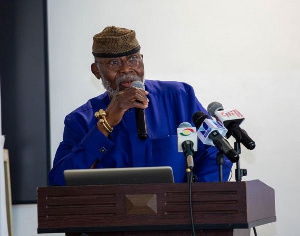Opinions of Saturday, 8 January 2005
Columnist: Fredua-Kwarteng, Y.
Ghana Flunks at Math and Science: Analysis (1)
In the 2003 TIMSS (Trends in International Mathematics and Science Study) mathematics test for grade eight, it was reported that out of the 45 countries that participated Ghana finished 44th. Ghanaian students scored 276 compared to the international average of 466. Some Ghanaians are quick to use Ghana?s dismal test score as a barometer of the crisis state of mathematics education in the country and the need for the government to take an immediate action to improve mathematics education. Yet others may reason that generally Ghanaians have never been good at mathematics; hence, that appalling performance is a reflection of our inherent weakness in mathematics. Many others may also argue that while the test partially reflects Ghanaian students? mathematics knowledge at that level, it is not indicative of the students? mathematics aptitude. We belong to this latter category of Ghanaian observers. However, we caution against any hasty conclusions on Ghana?s performance without a painstaking analysis or research.
This paper is a two-part analysis of the TIMSS grade eighth mathematics and science tests. The first part analysis focuses on mathematics teaching and learning in Ghana in relation to the nature of the TIMSS mathematics test for grade eight students. The second part analysis will deal with the TIMSS science test for grade eight. That part of our analysis will concentrate on the teaching of science in Ghanaian schools and the current trends in science education. We will argue that in most public primary schools in Ghana science is not taught and this often justified on the grounds of lack of scientific learning resources. Even where science is supposedly taught, it is presented as an exoteric subject whose comprehension requires the brain of an elephant, so to speak.
TIMSS officials acknowledge that a country?s performance at the test cannot be used as an absolute indicator of how that country is doing in terms of mathematics learning. They cited two major factors for this assertion. One factor has to do with the differences in pedagogical orientation of each participating country. Thus, a country whose national mathematics pedagogy is compatible with the one undergirding the test is more likely to do well than a country with different mathematics pedagogy. In Ghana, mathematics teaching at the eighth grade is characterized by the transmission and the command models. Teachers merely transmit mathematical facts, principles and algorithms, and students are commanded to learn them in a passive and fearful manner. Students are not encouraged to pose questions or engage in problem-solving activities in order to attain both conceptual and procedural understanding of what they are being taught. Students simply memorize the algorithms and regurgitate them during tests or examinations. Consequently, Ghanaian eighth graders are less likely to answer correctly, for example, the following algebraic question that appeared on the TIMSS test:
The cost, C, of printing greeting cards consists of fixed charge of 100 cents and a charge of 6cents for each card printed. Which of these equations can be used to determine the cost of printing n cards?
A. C= (100 + 6n) cents B. C= (106 + n) cents C. C= (106n) cents D. C= (600n)cents
The above question does not require solving a linear equation. Instead, it requires students to set-up an equation using the given information. This suggests that the skill to solve an equation is as important as the skill to set-up an equation. However, students can not learn the skill of setting up an equation unless they are provided appropriate opportunities to learn problem-solving and problem-posing. As the great mathematics educator, von Glasersfeld, rightly pointed out,? The child cannot conceive of tasks, the way to solve them and the solutions in terms other than those that are available at the particular moment in his or her conceptual development. The child must make meaning of the task and try to construct a solution by using materials she already has. That material cannot be anything but the conceptual building blocks and operations that the child has assembled in his or her own prior experience?. The point we want to stress is that given an open-class room environment, a student who has a thorough understanding of linear equations (i.e. in the form ax + b = c, where a, b and c are constants or fixed numbers except that a can not be zero) is more likely to pose many linear equation questions from his or her environment. This helps students to develop a strong conceptual understanding of what they are taught and to draw on it when needed.
The other factor TIMSS officials cited is the mathematics topics to which students have been exposed. Let us assume for this discussion that JSS 2 is equivalent to grade eight. It is unrealistic to expect students at that level to have some exposure to the mathematical concept of functions. Hence, these students are most unlikely to answer correctly the following question on the test:
The table below represents a relation between x and y. What is the missing number in the table?
X y
2 5
3 7
4 ?
7 15
A. 9 B. 10 C. 11 D.12 E. 13
Nonetheless, students who have had an exposure to patterns in a more conceptual way are more likely to answer this question by inspection without any formal understanding of functions.
Though TIMSS officials do not make any references to cultural differences between participating countries, these are an important factor that complicates a comparative analysis of the test scores. Culture in this context implies people?s interaction with their physical environment. From our professional experience, students are more likely to solve mathematical problems if they can relate to the cultural context of the problem. This is because the student?s familiarity with the cultural context, which includes both the signifier/signified and the special vocabulary used, makes it easer for him/her to translate the information into mathematical symbols. In fact, Ghanaian students? cultural experiences with ?parking lot? are almost non-existent. Parking lots in Ghana are not nicely divided into rows and columns as they are in other countries. Thus, the following math question which was one of the test questions is likely to cause some confusion to Ghanaian students at that level: There are 68 rows of cars in a parking lot. Each row has 92 cars. Which of these would give the closest estimate of the total number of cars in the parking lot?
A. 60 x 90 =5400 B. 60 x 100 = 6000 C. 70 x 90 = 6300 D. 70 x 100 =7000
From our professional perspective, a Ghanaian student at that level is unlikely to experience any cognitive confusion with this alternative question: There are 98 buses in a lorry park. Each bus has a maximum seat of 68 passengers. Calculate the total maximum number of passengers the buses will carry if each bus goes one trip.
Consequently, the TIMSS test as quoted above may not be fair to most Ghanaian students; in particular those from small towns or rural areas where there are practically no parking lots in the conventional sense of the word. Apart from the cultural aspect of that test item, there is also a pedagogical dimension. JSS mathematics teachers may drill their students in mental mathematics, but they always require exact answers rather than estimated or approximated answers. In fact, in a practical quantitative situation without access to a calculator, most people would do some sort of quick estimates in order to make sense of the situation. Therefore, the primary goal of mental math is to help students to develop or master the skill of estimating. On the contrary, in Ghana mental mathematics at both the primary school and JSS levels is designed for precision answers and speed with which the answers can be produced. These twin objectives of mental mathematics, precision and speed, are pursued regardless of the contexts of application of mathematical concepts, while valuable skill of estimating or approximating is completely ignored!
The language of instruction used in each of the participating country should also be taken into consideration in any comparative analysis of the test scores. Since Ghanaian students took the test in English (the so-called official language of Ghana), those whose first language is non-English are at great disadvantage. We are not surprised that countries that top-performed in the mathematics test--- Taiwan, Malaysia, Latvia, Russia- used their own language to teach and learn mathematics. The following test question, though a simple proportion, involves what Neil Postman, the late US educator, would call a fair amount of ?languaging?.
If there are 300 calories in 100g of certain food, how many calories are there in a 30g portion of this food?
A. 90 B. 100 C. 900 D. 1000 E. 9000
Our argument is that a Ghanaian student who is proficient in his or her mother or native language is most likely to answer that question correctly if the question were translated into that native language of the student. We are very much aware that the language of instruction in Ghanaian schools is a contentious issue. Some Ghanaians theorize that a person becomes increasingly proficient in a foreign language after using it over and over for a long time. Applying this line of reasoning to the case under discussion, as our grade eight students go through the grade-ladder they would eventually attain English proficiency needed for mathematical problem-solving. Nevertheless, the unfortunate thing is that most of these students would psychologically drop out of mathematics before they attain English proficiency! As well, some of the students may drop out of school before graduating from JSS 3. Some Ghanaians also argue that using English for instruction makes it possible for Ghanaians to ?transport? their education to any of the English-speaking countries. But as we have argued in one of our articles on mathematics education, when Ghanaian students at the secondary level enroll in schools in Canada they are confronted with two main tasks. They have to find the meaning of mathematical concepts and also the words to communicate the meaning of those concepts. Asian students, on the other hand, have to find the words to express their understanding of mathematical concepts. This is because they have already learnt the meanings of mathematics concepts in their own language. So whose education is more portable?
Further, the issue of sampling is extremely important in a comparative test score analysis. According to the report published in both Ghanaweb and Ghana Review International on December 15, 2004, a hundred and fifty Ghanaian schools took part in the test. Who selected the schools? What procedure was used in the selection of the schools? What were the justifiable criteria for inclusion or exclusion of schools from the sample? To what extent can we say that the sample is typically representative of Ghanaian schools? If another 150 schools in Ghana were selected to participate in the same test, what is the probability that the same score would be obtained? If, for example, the schools were selected from urban cities such as Accra, Kumasi, Tamale, or Cape Coast, then the sample is unrepresentative of Ghanaian schools. Moreover, if the tests were administered to another sample of 150 Ghanaian schools and different results were obtained the test would be unreliable. Information on the sampling method is crucially important because it would indicate the degree of reliability we can place on the test scores. Furthermore, the mathematics educational background of teachers who teach grade eight mathematics is equally an important factor for any comparative analysis of the test scores. In some of the participating countries grade eight teachers have university education in mathematics, even some at the post- graduate level; while in others the teachers have an equivalent of two years university education in mathematics. In Ghana, a grade eight mathematics teachers may not have such a background in mathematics. Mathematics training or education of grade eight teachers is most important for effective teaching than mere graduation from teacher training colleges or universities. Our main contention is that the differing teacher mathematics background is a factor that affects the test scores of participating countries.
Though we take the TIMSS math scores as a partial measure of mathematics education up to grade eight in the participating countries, they can not be used as a measure of mathematics aptitude of students due to the factors we have discussed above. As well, for Ghana in particular our test score teaches us a couple of lessons. First, it teaches us that our mathematics methodology and pedagogy must change to allow students opportunities for problem-solving, problem-posing, and active participation in mathematics learning in the classroom. The mathematics classroom should be organized as a community of critical learners. So that when students pose mathematics questions they are not necessarily directed at the teacher but to the community. The community members, the students and the teacher, are free to discuss mathematical ideas, question assumptions, ask questions for clarification, and make mistakes without any fear or intimidations from either the teacher or the other community members. In a community of critical mathematics learners, the teacher does not do all the talking while the students passively listen or take notes. Moreover, in such a community the teacher provides rationales, justifications, logic or cultural reasons for mathematical rules, principles, or algorithms; nothing is taken for granted. Besides, in that community the teacher is not necessarily the final arbiter of mathematical disagreements or disputes; bargaining, negotiating, dialogue and research may be used to resolve differences. The teacher also uses local referents and inputs from the students? cultural environment in teaching mathematical concepts.
The urgent need for pedagogical and methodological change in Ghanaian schools was, unfortunately, not addressed by the Presidential Committee on Education Review. The committee was rather preoccupied with structural matters such as new curriculum, apprenticeship program, the length of senior secondary schooling, and professional development training for teachers. The professional development of teachers, we presume, is not about a shift in pedagogical orientation; on the contrary, it is about increasing teachers? subject-content knowledge. The government white paper also lent credence to the committee?s belief that about 60 percent of JSS students who usually drop out of school before completing JSS or, fail to enrol in SSS program do so because of the lack of apprenticeship program or too many subjects for to learn. The ways teachers teach in primary school, JSS and SSS have never been interrogated or examined. Why? In fact, we reject outright the simplistic notion that has been peddled around for a long time that Ghanaian teachers are better than their counterparts in other countries. Any country that fails to engage in a program of continuous improvement of its teachers? way of teaching is destined to the dustbin of history. It should also be noted that constructing a new curriculum, increasing the length of senior secondary schooling and establishing apprenticeship programs are unlikely to improve schooling outcomes for Ghanaian youth without a corresponding change in teaching methodology and pedagogy. We have enough empirical evidence to show that some students drop out of school because of the manner in which teachers teach. Students who repeatedly complain in private that they can not make sense of what is being taught have a high probability of dropping out of school.











